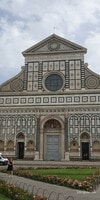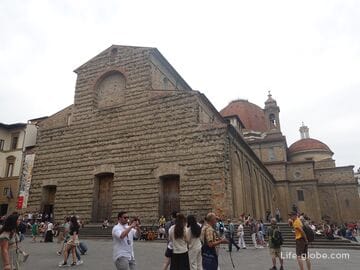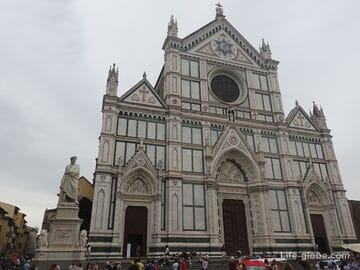Santa Maria Novella (Basilica di Santa Maria Novella) is a historic monumental church in Florence, which is one of the most important in the city and has famous frescoes from the Gothic and Renaissance eras.
Today it is a church and a museum with works of art. Practical information about the visit is given at the end of this article.
It is the first great basilica of Florence and the main Dominican church of the city.
Santa Maria Novella is a complex that is one of the main attractions of Florence.
The complex includes: a basilica with chapels and a sacristy, adjacent monasteries, the chapter house, the Avelli cemetery, the abode of the Dead, a refectory and museum exhibitions.
The complex is located in the historical part of Florence, on the square of the same name Santa Maria Novella (Piazza Santa Maria Novella).
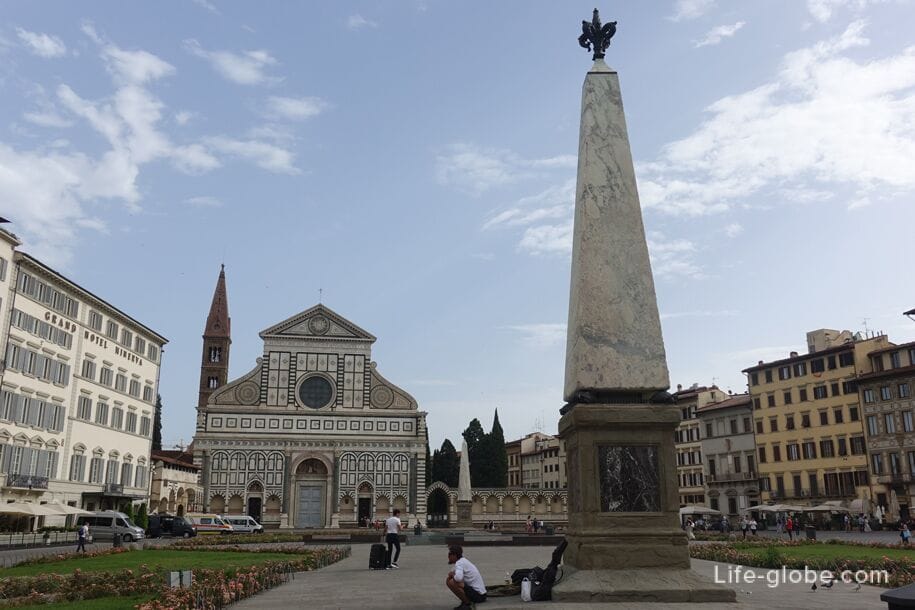
The church with the monastery was founded by Dominican monks and built in the 13th-14th centuries, on the site of the 9th-century chapel of Santa Maria delle Vigne. Hence the modern name of the church of Santa Maria Novella ("New"). The construction was completed with the construction of a Romanesque-Gothic bell tower and a sacristy. In 1360, a number of Gothic arcades were added to the facade, which were intended to accommodate sarcophagi. In 1420 the church was consecrated.
The bell tower, reaching a height of more than 68 meters, was built between 1332 and 1333 by Jacopo Talenti. Inside there are 5 bells cast in 1764 by the Florentine founder Alessandro Tognozzi Moreni (with the exception of the small one, which is the work of the Pistoia founder Rafanelli).
After its construction, the church became the first basilica of Florence, and soon turned into the main Dominican church of the city.
Subsequently, the complex received beautiful external and internal decorations, created, among others, by Leon Battista Alberti, Giotto, Brunelleschi, Masaccio, Michelangelo, Ghirlandaio, Botticelli and Vasari. Thus, the complex contains numerous artistic treasures and funerary monuments. Especially famous are the frescoes of the Gothic and early Renaissance masters, who financed the most important Florentine families, thereby securing funeral chapels on consecrated ground.
Today, the Santa Maria Novella complex is one of the most important religious and artistic attractions of Florence and Italy as a whole.
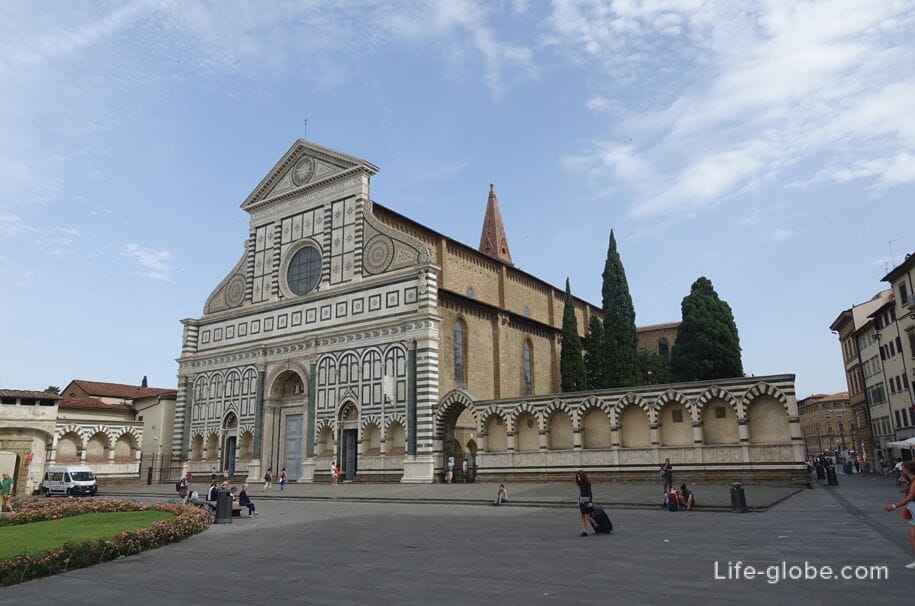
Basilica of Santa Maria Novella
The basilica building combines elements of Gothic and early Renaissance architecture.
The main facade facing the square of the same name is decorated with a portal flanked by two Corinthian order columns lined with green marble. The entire facade is decorated with white and dark green marble with geometric patterns. This technique was called the "inlaid" or "Romano-Florentine" style.
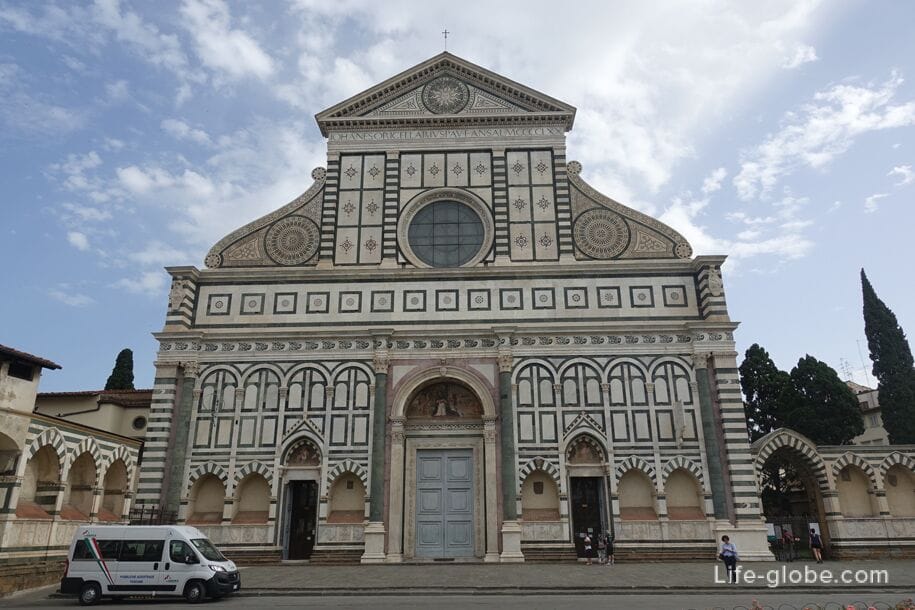
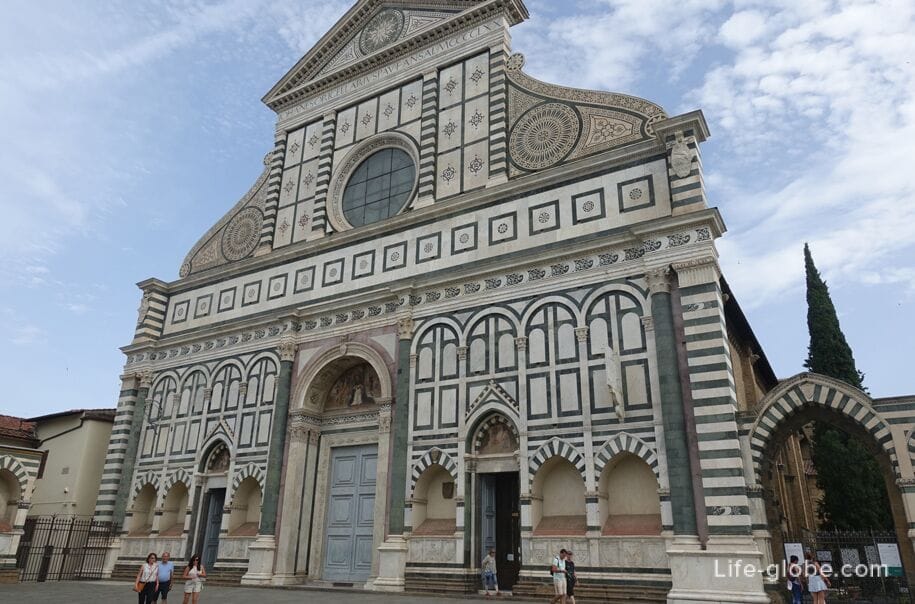
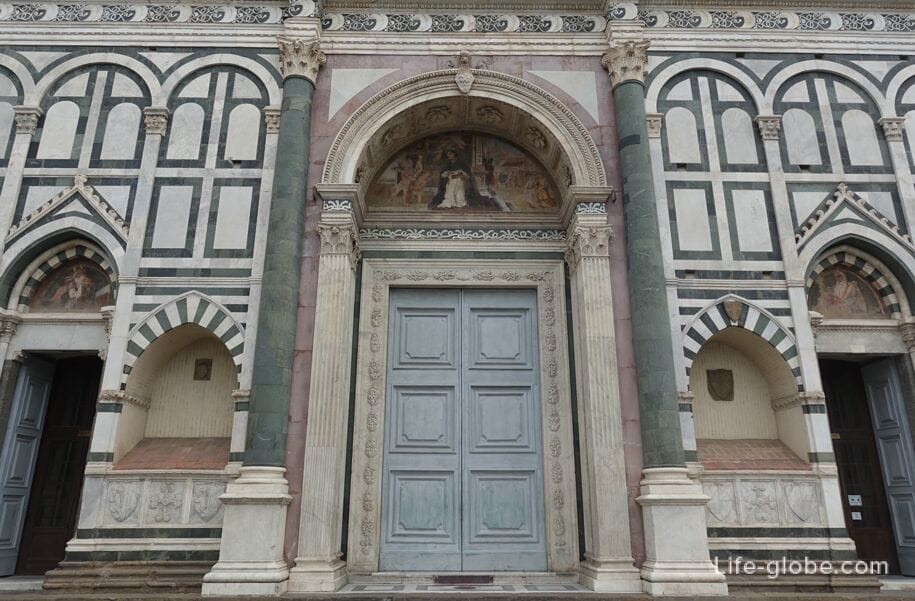
On the frieze under the pediment there is an inscription in Latin mentioning the name of the builder of the church: IOHANES ORICELLARIVS PAV FAN SAL MCCCCLXX (Giovanni Rucellai, son of Paolo, in the blessed year 1470).
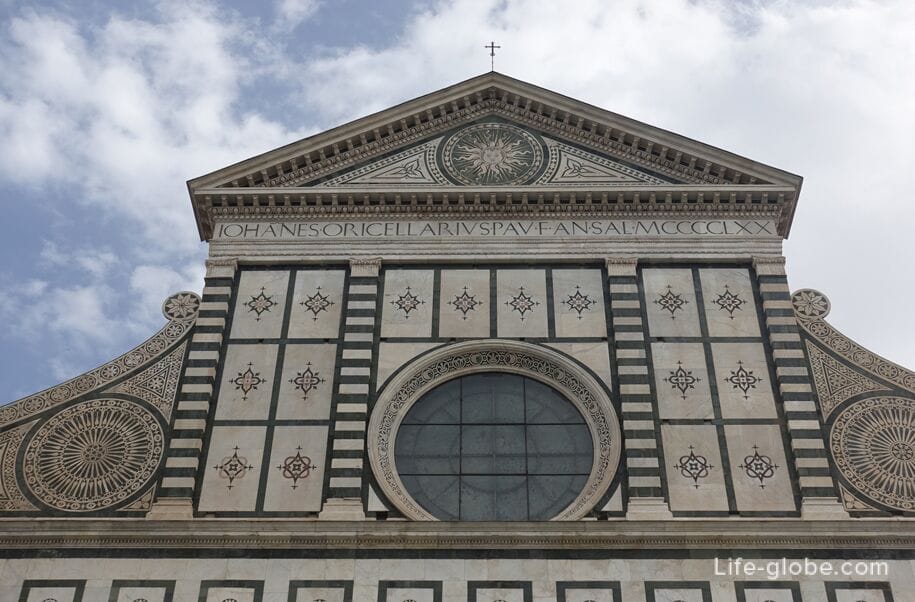
In the lower tier of the church and on the walls of the cloister there are typical Byzantine-Arabic pointed "striped" arches forming arched niches.
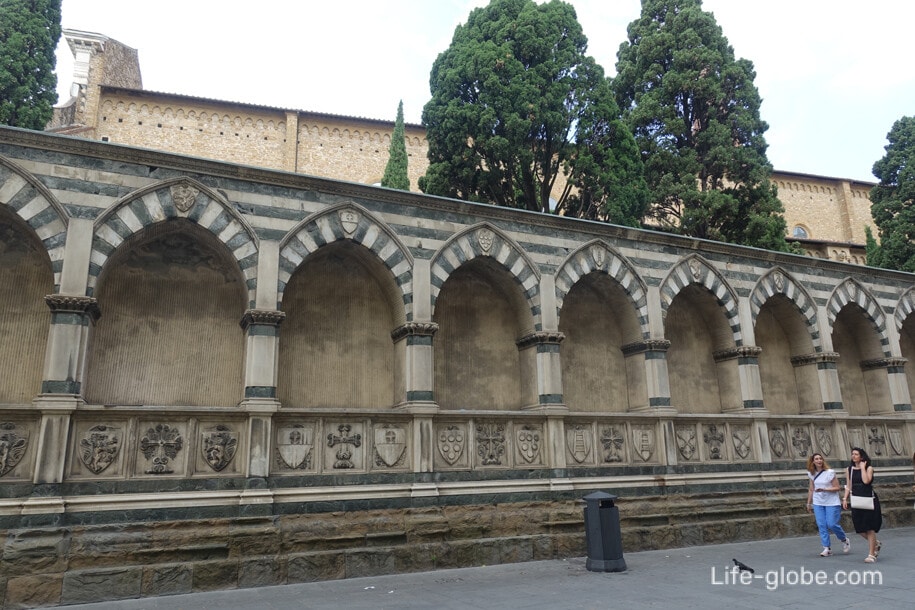
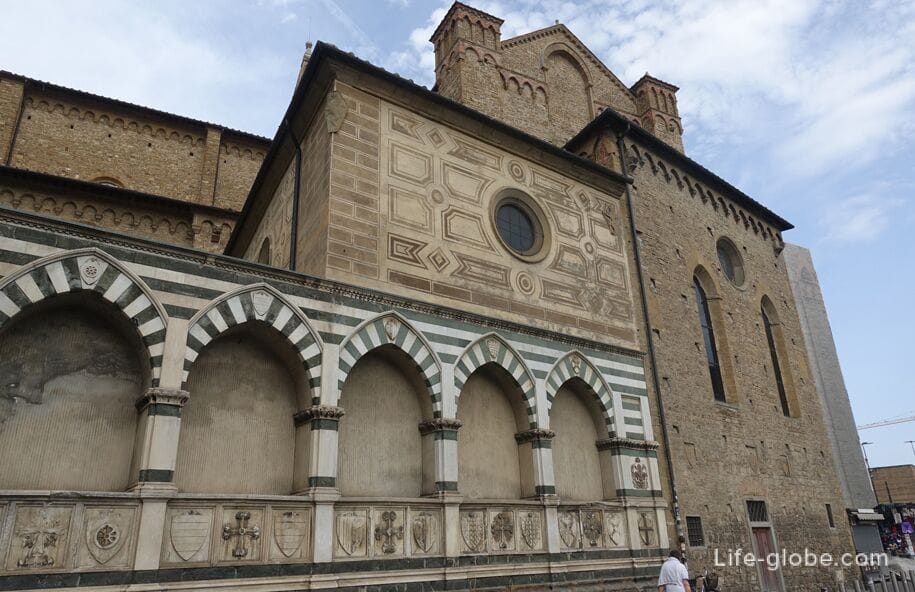
The exterior, facing the eponymous railway station, looks more austere because it has no bright decorations.

The basilica in plan is a Latin cross and has three naves separated by columns with arches.
The vault emphasizes the Gothic appearance, contrasting with the works of Renaissance art located in the church.
The stained glass window of the main facade (rose) depicting the Coronation of the Virgin was created in 1365 and is visible from the inside.
Inside the church there are valuable works of art: altars, frescoes, tombstones.
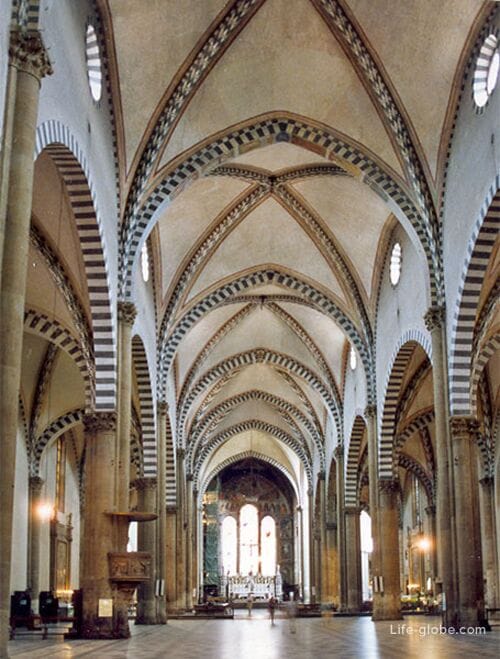
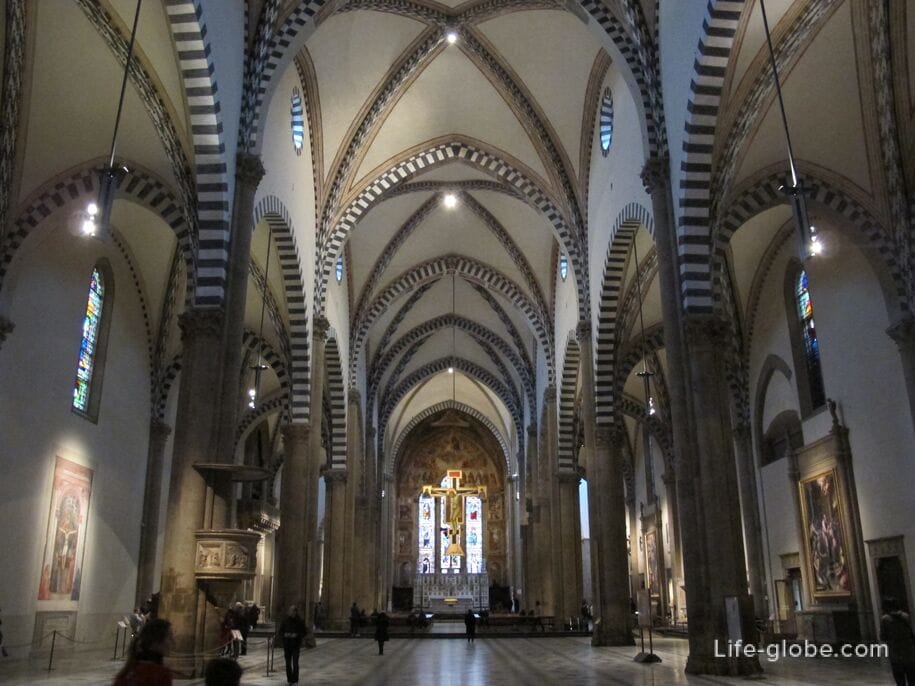
In the center of the main nave, you can see a Crucifix by Giotto, who most likely created it between 1288 and 1289. The crucifix hangs at the top like the banner of a sovereign God.
The main feature of the Crucifixion is that Jesus, crucified on the cross, is depicted in a realistic body, no longer idealized, as in Byzantine art, but vital.
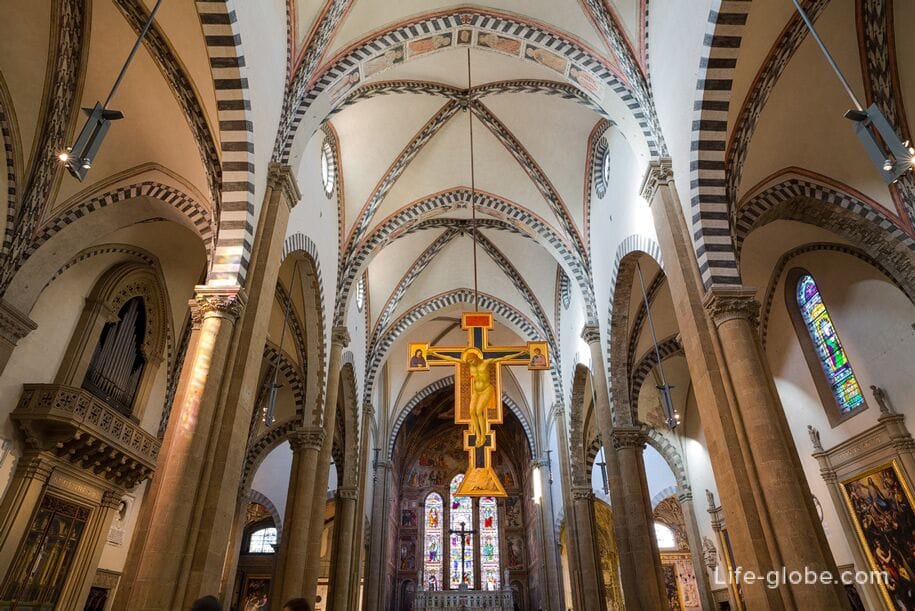
The Chapel of Filippo Strozzi is famous for the series of frescoes made by Filippino Lippi from the late 80s of the fifteenth century until 1502.
The chapel was built by order of Filippo Strozzi the Elder, who bought the patronage of the chapel from the Boni family around 1486.
The theme of the frescoes of the chapel is the life stories of Saints Philip the Apostle and John the Theologian: the first is connected with the name of the customer, the second with the name of the early patron of the chapel.
The chapel also has a lancet window with an image of the Madonna and Child above and Saints John the Theologian and Philip below.
Behind the altar is the porphyry tomb of Filippo Strozzi, created by Benedetto da Maiano (late 15th century), over which he placed a marble bas-relief of the Madonna and Child surrounded by a garland of roses and four angels in flight. The same sculptor also sculpted a bust of Filippo Strozzi for the monument, which the family kept in their palace until 1878, when it was sold to the Louvre.
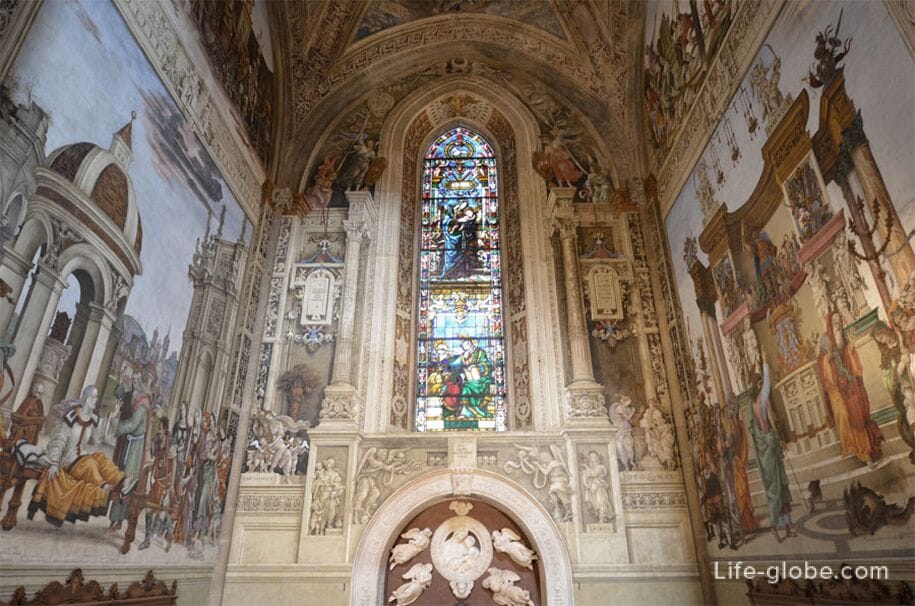
The Tornabuoni Chapel or the Great Chapel is the main chapel of the basilica and is dedicated to Madonna Assunta.
The chapel has a large cycle of frescoes, by Domenico Bigordi di Tommaso Ghirlandaio, whom Giovanni Tornabuoni invited to paint the chapel after he bought patronage from the Ricci family in 1485.
The walls depict stories dedicated to the life of the Virgin, taken from the apocryphal gospels (left), and St. John the Baptist, the patron saint of Florence (right). The frescoes also depict members of important Florentine families. There are medallions with images of evangelists on the vaults.
The present altar of precious marble was designed by Enrico Romoli, director of restoration in 1860. The sculptures belong to Egisto Rossi, and the crucifix on the altar was attributed to Gianbologna and was donated by the Academy of Fine Arts of Florence.


The Chapel of Gondi, which dates from about 1410-1415, stands out with a wooden Crucifix by Brunelleschi.
According to legend, this work was created in response to Donatello's wooden crucifix in Santa Croce in Florence, which Brunelleschi criticized for irritating naturalism and which he defined as a "peasant on the cross" instead of a body similar to Jesus Christ, who in all his parts was the most perfect man ever born. Thus, prompted by Donatello's work to do better, Brunelleschi created a Crucifix, at the sight of which his friend was so amazed that he fell to the ground and broke the eggs that he was holding on his lap and brought with him to lunch to his friend and make him say: "You are allowed to be Christ, and I am a peasant".
In the vault of the chapel there are fragments of frescoes by the Greek-Byzantine masters of the 14th century (one of the oldest in the church). The polychrome marble decor was applied by Giuliano da Sangallo (circa 1503), and the stained glass dates back to the 20th century.

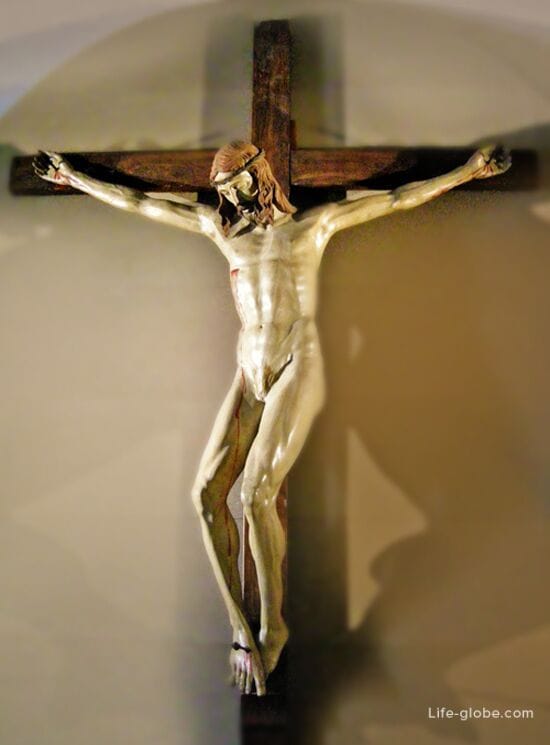
The Strozzi Chapel in Mantua is covered with valuable frescoes dating from 1350-1357, which are among the best works of Nardo di Chione (brother of Andrea Orcagna) and represent the heavenly realms structured according to Dante's "Divine Comedy": on the main side is the wall of the Universal Judgment, where there is also a portrait of Dante, Hell - on the right and Paradise - on the left . On the main altar, the Redeemer with the Madonna and saints from Orcagna.
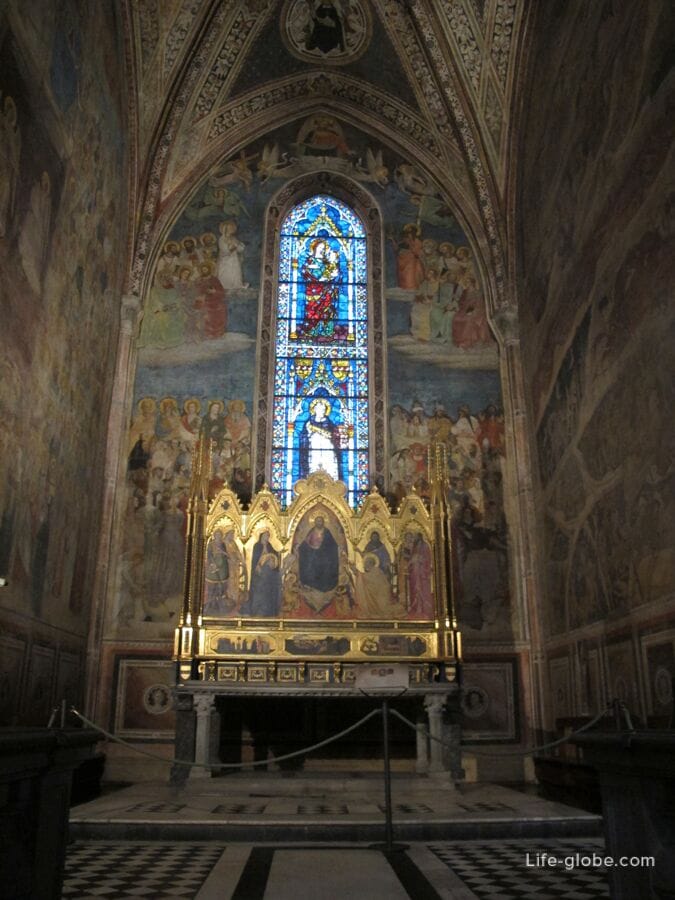
In the third arch of the left nave of the basilica, in place of the altar, there is a fresco "Trinity" by Tommaso Guidi, known as Masaccio (1425-1426).
This magnificent architectural composition, one of the first and most perfect examples of Renaissance perspective, is still a school for artists, as in the first half of the 15th century. At the height of the chapel, similar to the classical triumphal arch, the Eternal Father is depicted at the top, the Holy Spirit in the form of a dove and Jesus crucified between the Madonna and John the Theologian at the bottom. On both sides, below, the figures of the patrons of the chapel - husband and wife.
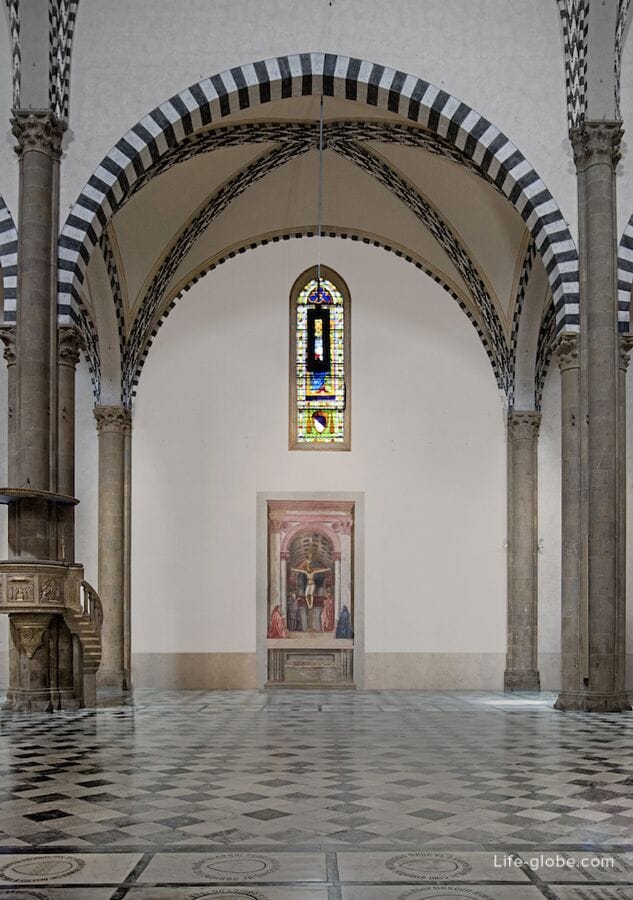

Also in the church are other chapels, organs and a sacristy, which is accessible through a monumental portal of the 17th century and was originally built around 1380 as the Chapel of the Annunciation in honor of Maynardo Cavalcanti.
The marble and glazed terracotta sink in the sacristy is the work of Giovanni della Robbia from 1498 to 1499, and symmetrically located on the right of polychrome marble is the work of Gioacchino Fortini from 1733-1734.
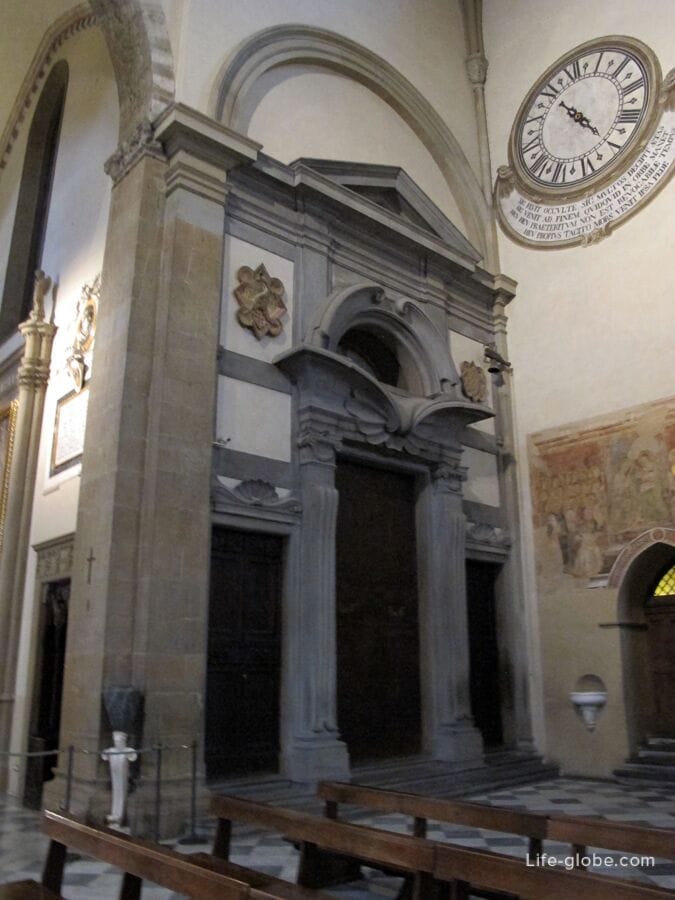
Cemetery with chapel
A small cemetery of Avelli with cypresses planted in the nineteenth century opens to the right of the basilica, on land that was used as a burial place until the end of the 19th century.
In the inner fence there is a motif of tombstones with sculptural coats of arms.
The space got the name "Avelli" because it runs along the Via degli Avelli street, from which it is fenced with a wall.
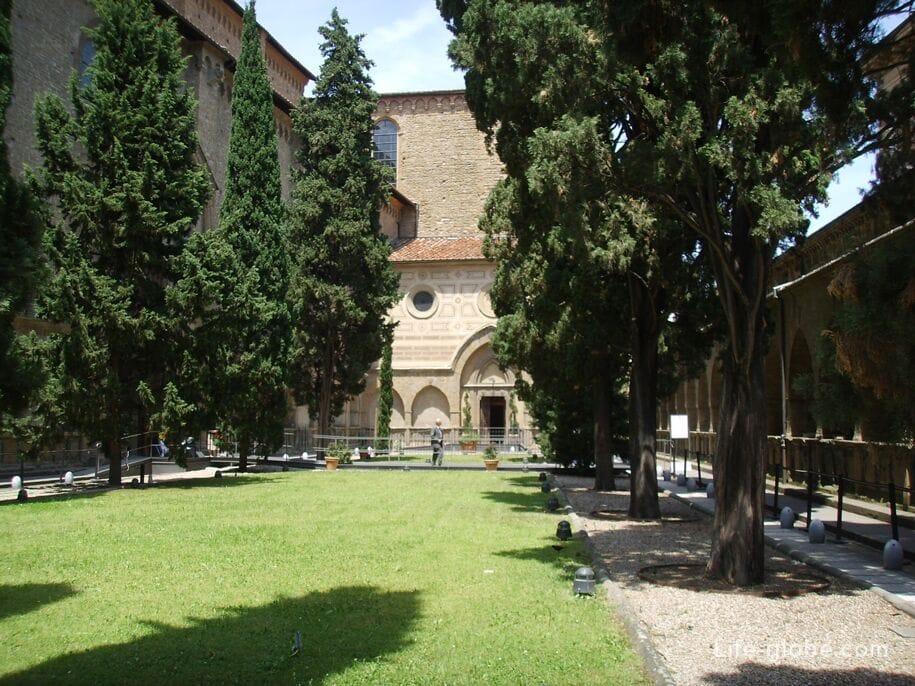
There is also the Chapel of Pura (La Cappella Della Pura), which is used as a place of worship when the basilica is open to tourists.
The chapel dates back to 1474, when it was rebuilt by Ricasoli to accommodate the image, which is considered miraculous, of the Madonna and Child and St. Catherine. The chapel is mainly of classical appearance (reconstruction of the 19th century) partially preserved the columns of the Renaissance period.
On the altar is a wooden crucifix made of a Lebanese cedar cross with a four-petalled image of scenes from the life of Christ - this is the oldest part was restored in 1980.
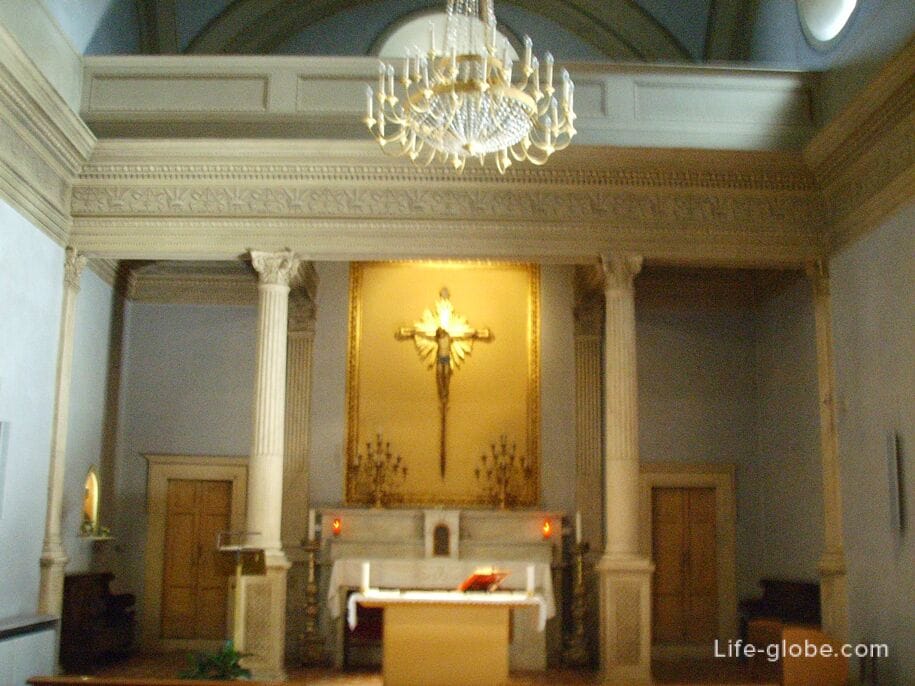
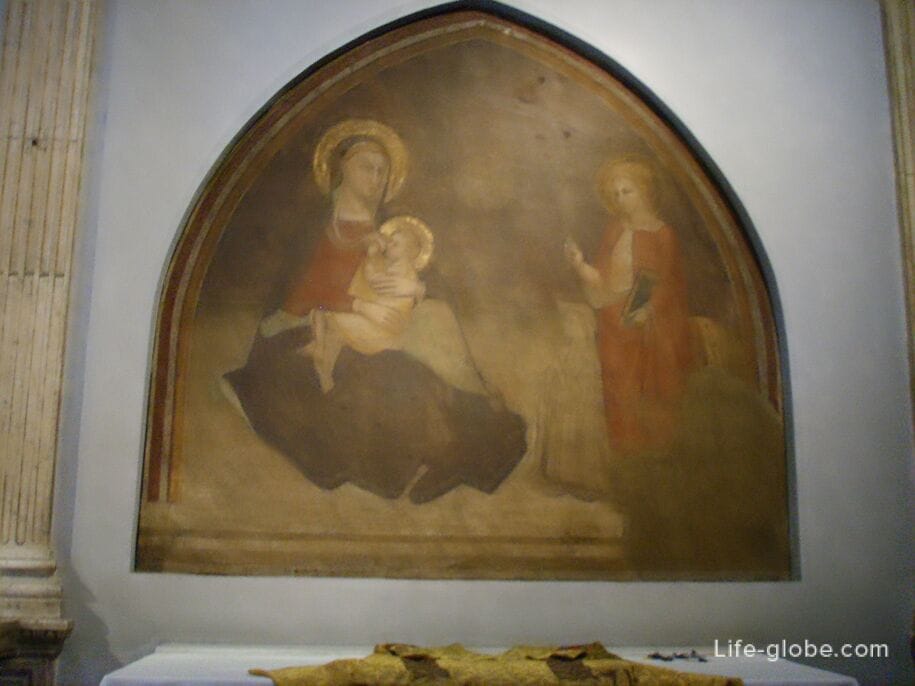
Santa Maria Novella Museum Complex
In addition to the basilica with the adjacent cemetery, the Santa Maria Novella complex includes other objects that are part of the current museum.
The Green Monastery
The Green Monastery (Il Chiostro verde) was built around 1332-1350 by Fra Jacopo Talenti (Italian architect and Dominican monk of the monastery of Santa Maria Novella).
The monastery has an inner courtyard surrounded by an arcade of arches on three-dimensional pillars.
The monastery was painted with frescoes of green earth (pigment based on iron oxide and silicic acid), hence the name, in the first half of the fifteenth century.
The monastery is known for a cycle of frescoes partially executed by Paolo Uccello around 1425-1430. Other artists involved in the decoration include Giorgio Vasari and Dello Delli.
The oldest paintings date from the fourteenth century and are in the northwest corner, with a Crucifix between Saints Domenico and Tommaso (attributed by Vasari to the mysterious Stefano Fiorentino), a Madonna and Child in the Sienese style (circa 1330, above), a sixteenth-century fresco with Saints Domenico and Pietro Martire and a Dominican tree of the second half of the 14th century. In the arches on the sails are painted busts of Dominican saints and blessed, incomplete and dating from the fourteenth century.
The most interesting are the works of Paolo Uccello with the "Stories of Being", which unfold on the north side, in the continuation of the lobby.

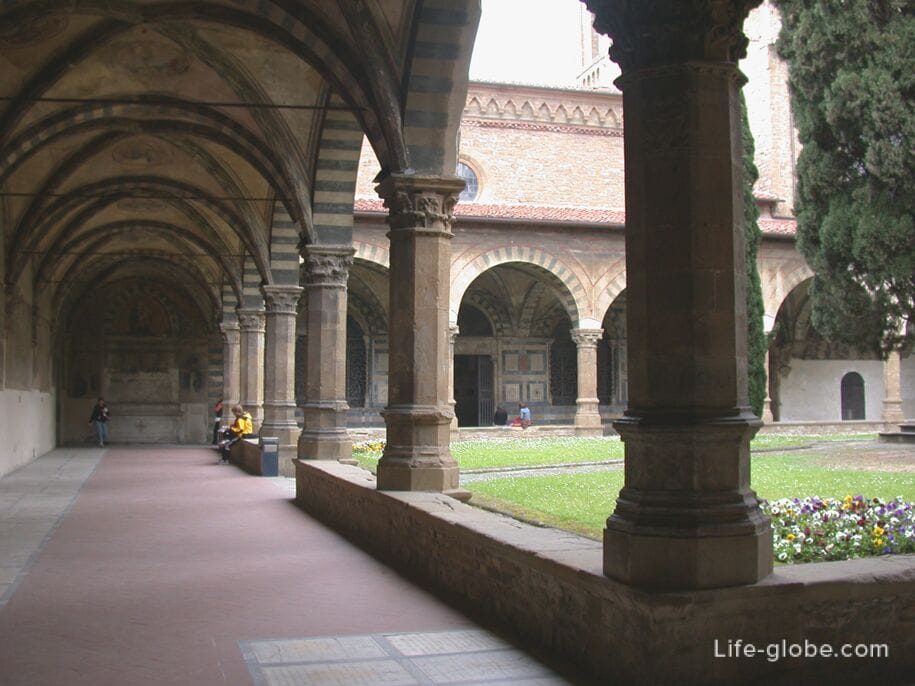
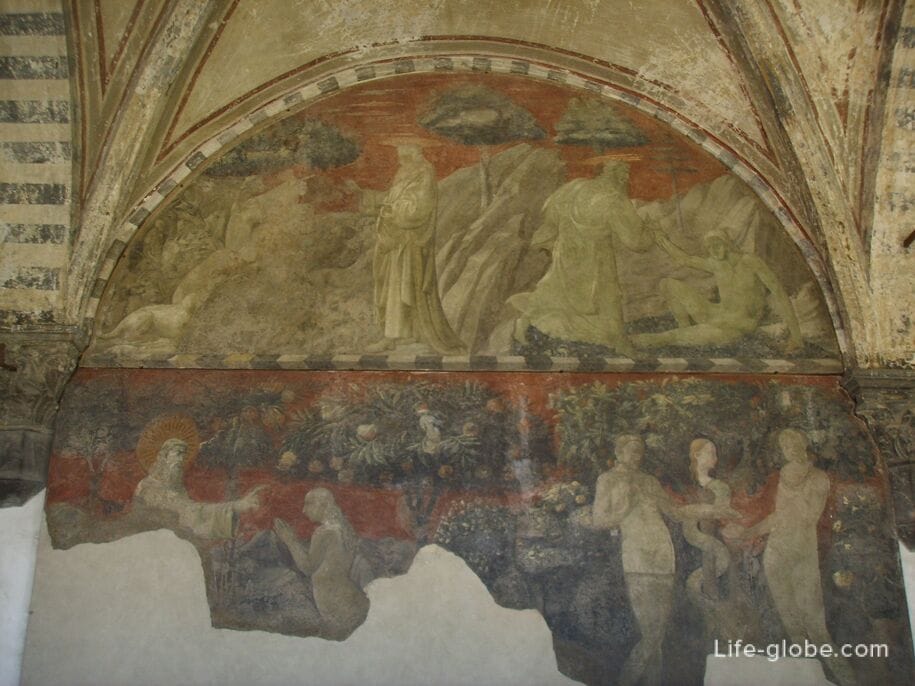
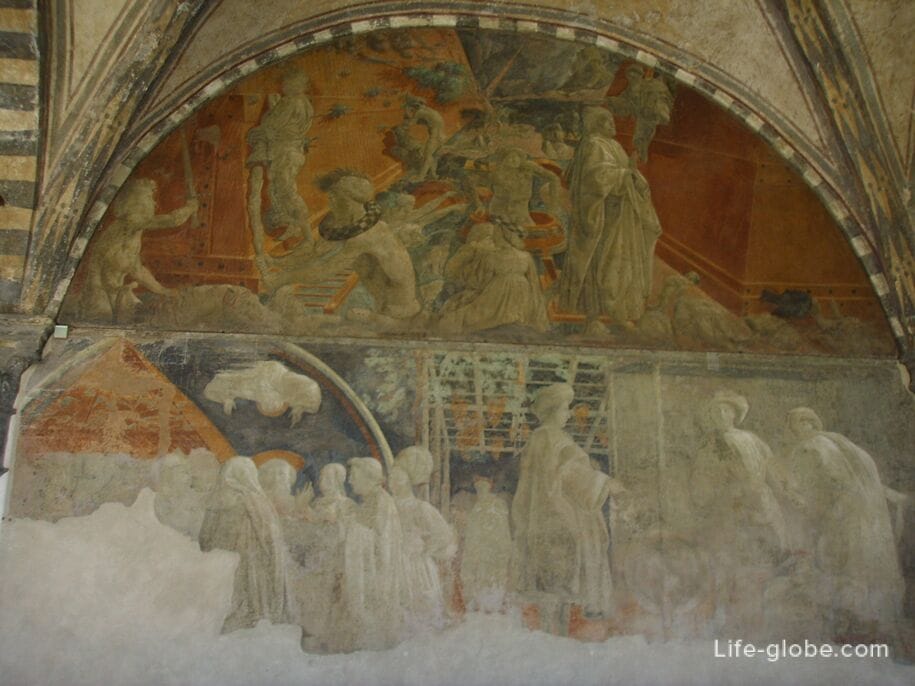
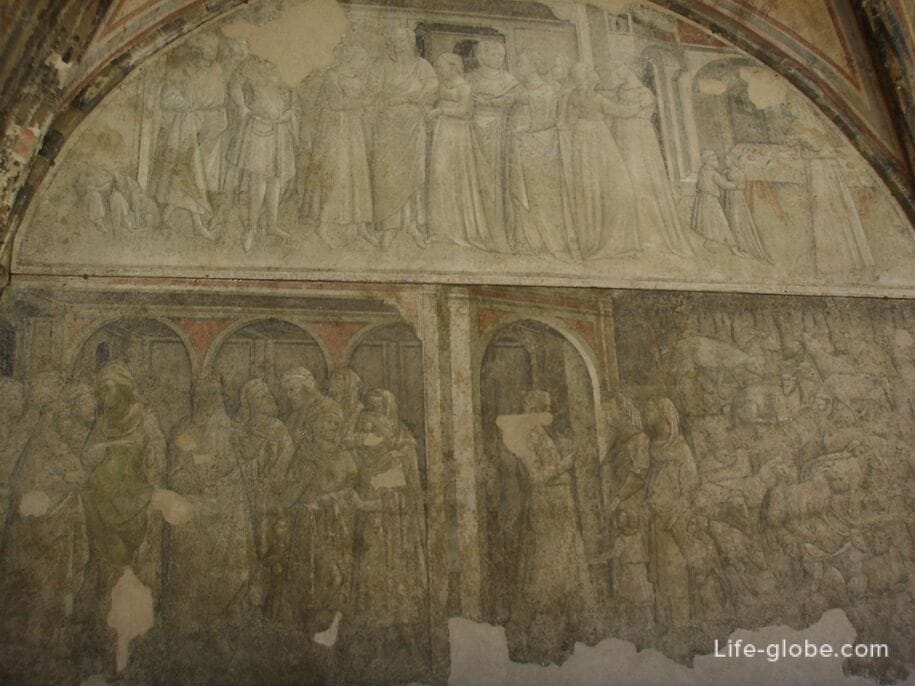
Chapel of the Spaniards (Spanish Chapel)
On the north side of the Green Monastery is the former chapter of the church - the chapel of the Spaniards (Cappellone degli Spagnoli).
The chapter received the name "Spanish" in 1566, when it was transferred to a colony of Spaniards who had been gathering here since arriving in the city after Eleanor of Toledo, who married Cosimo I de' Medici in 1539.
The chapel is known for a rich cycle of frescoes by Andrea di Bonaiuto (1365-1367), which, thanks to the restoration, are clearly visible and depict the role of the Dominicans in the fight against heresy in various scenes.
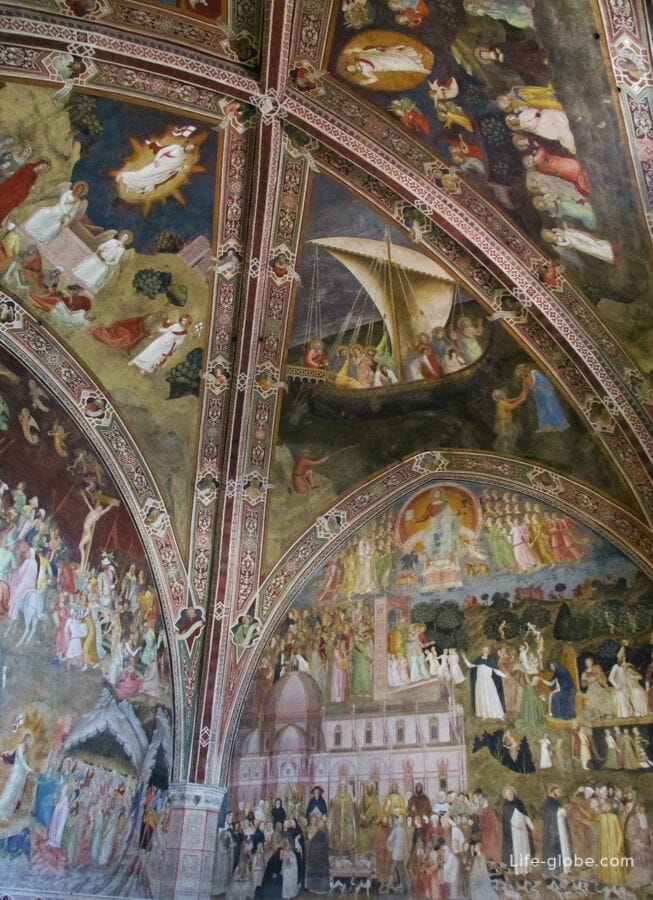
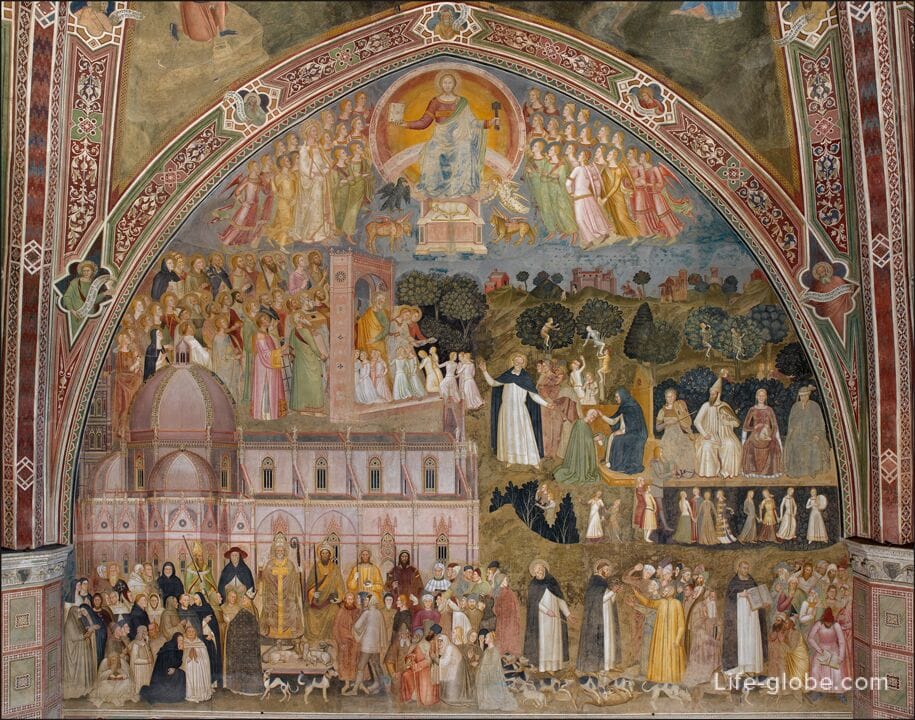
Refectory
From the Green Monastery you can go out into the passage, which is called the four doors, because it has doors on each side.
One of the rooms (Chapel Ubriaki, Cappella degli Ubriachi) has an almost square plan and architecture of the fourteenth century. There are various works of art here: a synopia of frescoes by Paolo Uccello, 35 figures of prophets from the workshop of Orcagna, once inserted along the columns of the Tornabuoni Chapel, a polyptych by Bernardo Daddi, previously located in the Spanish Chapel, and various precious objects contained in the showcases, such as busts-reliquaries of the Sienese schools of the fourteenth century (including busts of Sant-Orsola and one of his virgin companions) and Paliotto del Assunta, as well as precious fabric embroidered with brocade velvet on canvas.
The next room is the refectory, built by Jacopo Talenti around 1353 with four spans of ribbed cross vaults. There is a fresco of the Madonna enthroned and the Dominican saints by the disciple Agnolo Gaddi surrounded by a flaming theory of characters in an unambiguous Mannerist style ("Miracles of the Exodus"), by Alessandro Allori from 1597. In fact, Allory painted the fresco as a frame for one of his tables with the image of the Last Supper (1584), located on the next wall.

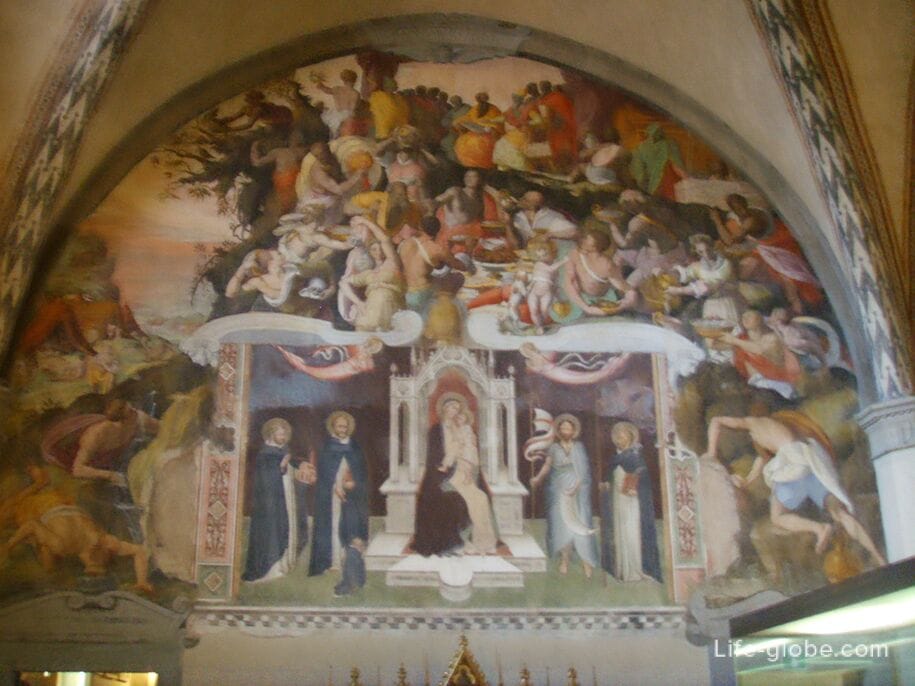
Monastery of the Dead (Monastery of the Dead)
The Monastery of the Dead (Il Chiostro dei Morti) is a former lower (underground, which shows that the monastery was below the level of the church itself) cemetery built by the Dominicans around 1270, and probably reusing the previous monastery of the canons.
The space has arches on two sides with low cross vaults on octagonal pillars (usually of the fourteenth century) with an upper gallery supported by projections that leads from the ancient dormitory to the sacristy of the church. Part of the premises of the former monks' dormitory today houses the Dominican Library of Santa Maria Novella, which has more than 40,000 volumes.
In the monastery of the Dead there is a Strozzi funerary chapel (now the Chapel of the Annunciation) with two walls with frescoes depicting the Nativity and the Crucifixion attributed to Andrea Orcagna or his school; the third wall represented the Annunciation, but was demolished in the early 20th century.
The walls of the monastery of the Dead are dotted with tombstone coats of arms (many from the 14th century, often with the ancient heraldic forms of the famous Florentine balsons), and tombstones are mostly built below, especially from the 19th century.
The eastern side of the monastery is divided by walls forming deep chapels: Sant'Antonio Abate with the image of the Crucifixion and the History of Sant'Antonio; Sant'Anna, with the stories of Sant'Anna and Maria; San Paolo with the Crucifixion and San Domenico. The frescoes in the chapels are quite ruined.
According to eighteenth-century sources, when the Gothic basilica was still under construction, the functions of the church were performed in this space, which explains the presence of chapels and temporary altars.
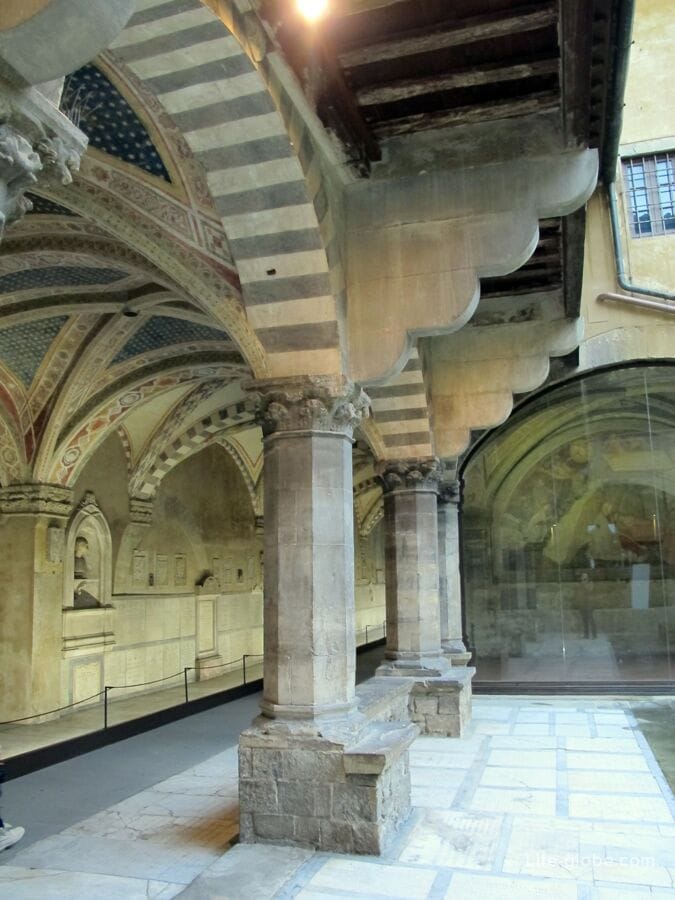
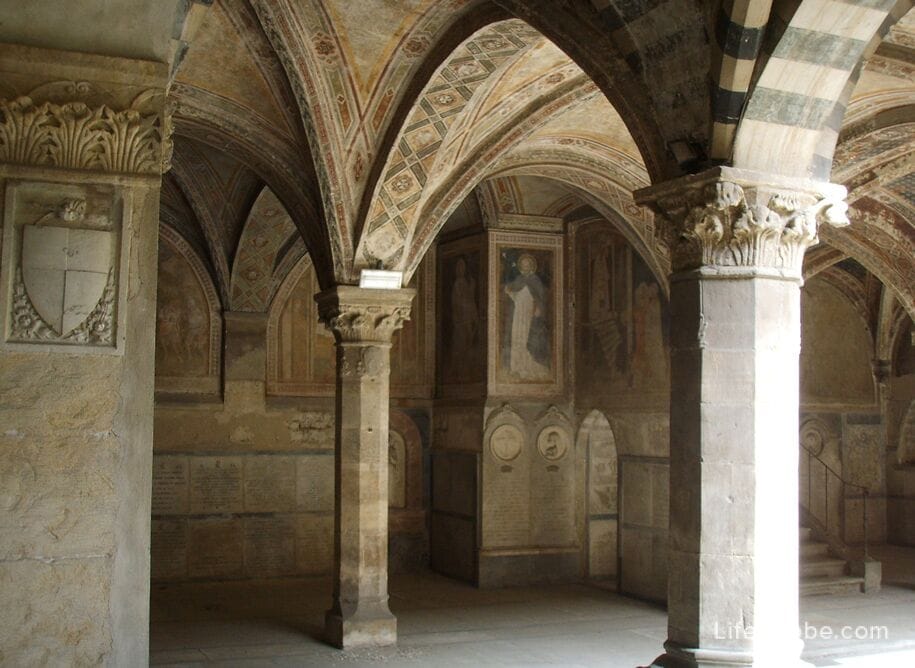

The Great Monastery of Santa Maria Novella
The large monastery of the Santa Maria Novella complex (Il Chiostro Grande) is the largest in the city and it was rebuilt in 1562-1592 by architect Giulio Parigi commissioned by Eleonora da Toledo. The monastery was also painted with frescoes by Florentine artists of the 16th and 17th centuries (Pochchetti, Santi di Tito, Chigoli, Alessandro Lavra, etc.) with stories about Christ and Dominican saints.
There is an ancient library, the former papal apartments, of which only the chapel of the Popes (La Cappella dei Papi) who visited Florence remains, and a former dormitory with three long naves supported by monolithic columns.
The Chapel of the Popes is frescoed by Ridolfo del Ghirlandaio (Assumption of the Virgin) and the young Pontormo (1515), who created the eloquent figure of Veronica, who raises the canvas with the face of Christ, with the composition and use of colors that were typical for Mannerists. In addition, the ceiling is painted with original grotesque motifs on a dark background, with nine paintings depicting angels, other figures and Medici coats of arms.
The Great Monastery is also called the Second Monastery, since it was built after the Green Monastery adjacent to the Basilica of Santa Maria Novella.
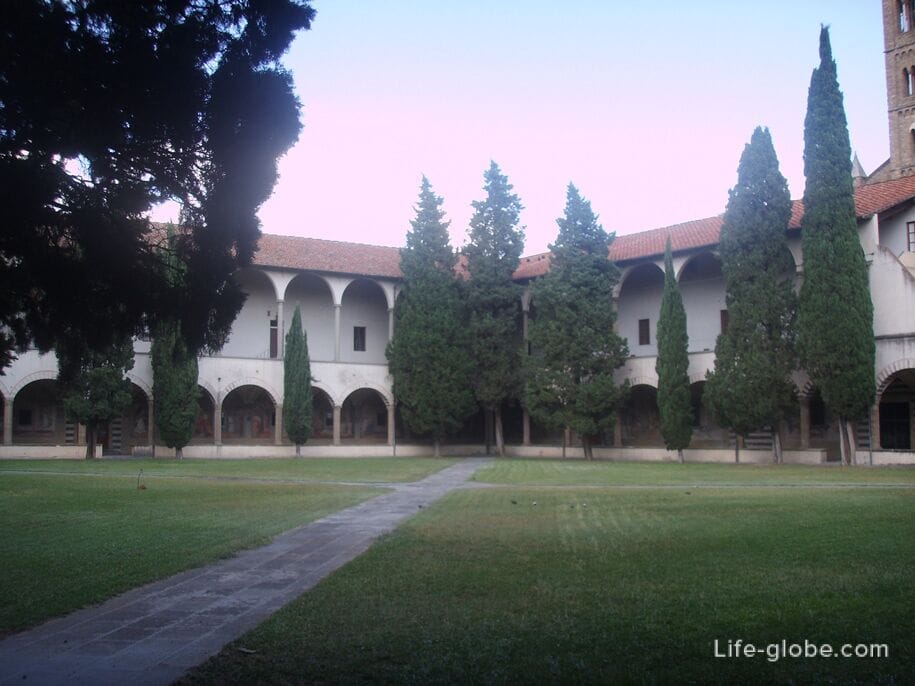
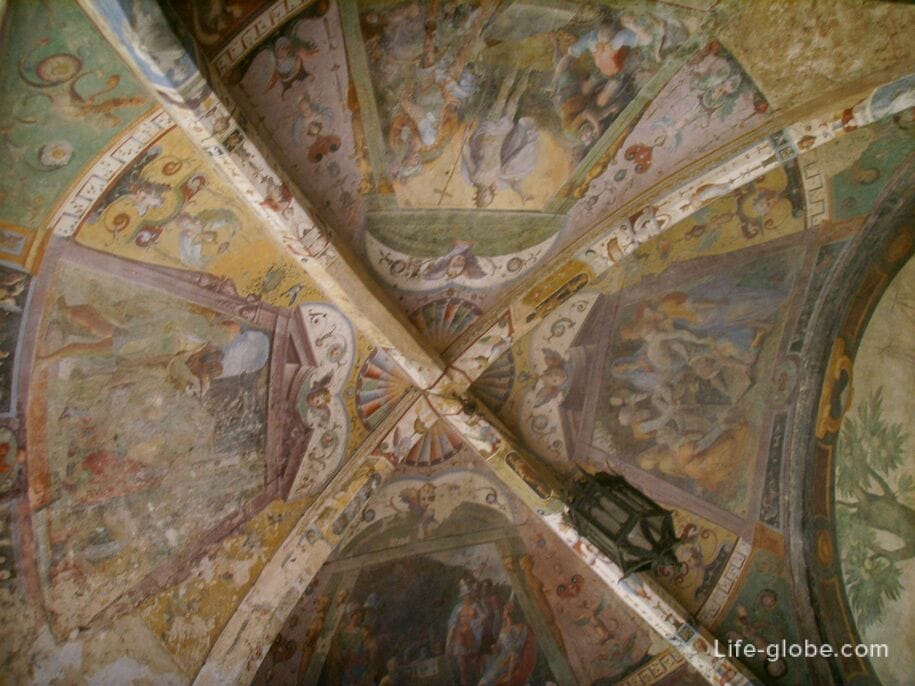
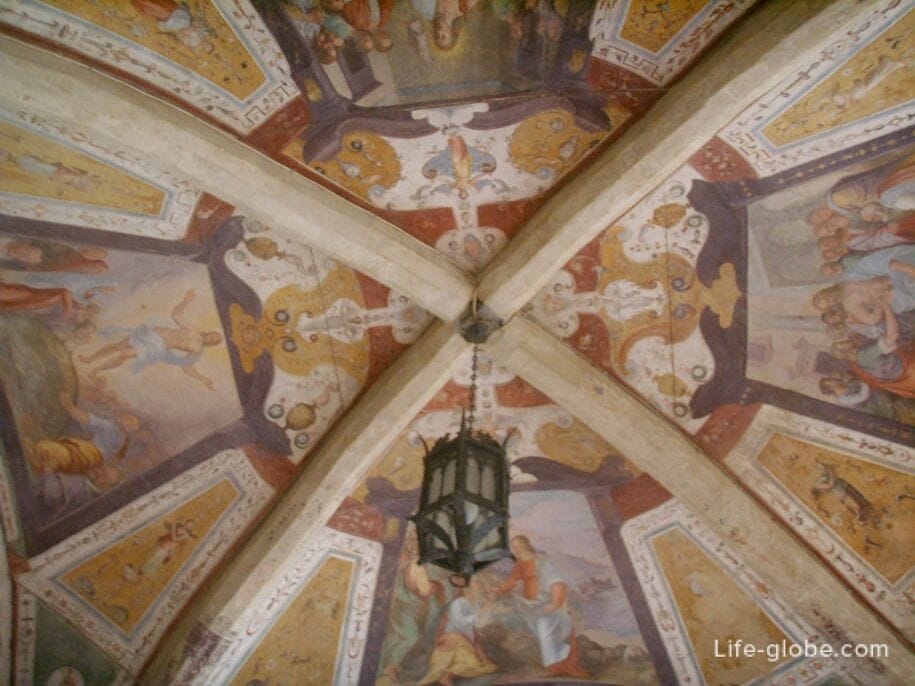
Chapel of the Popes
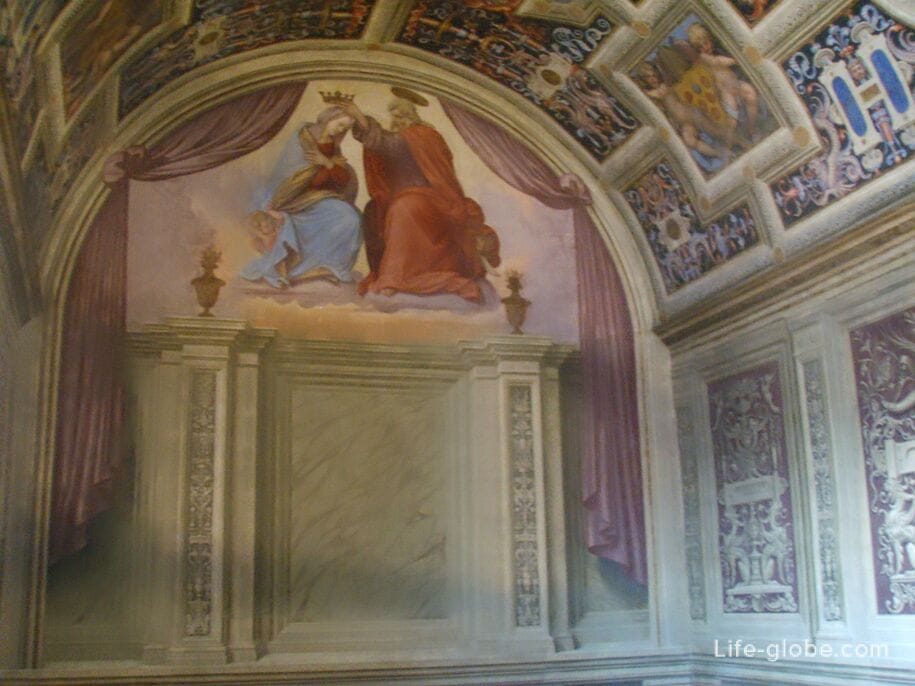
Santa Maria Novella Pharmacy
On the south side of the monastery (entrance from Via della Scala, 16) there is an old perfume and pharmaceutical workshop called "Pharmacy Santa Maria Novella" (Farmacia di Santa Maria Novella), which still exists and is one of the oldest in Europe, open continuously since the seventeenth century.
This is the most famous pharmacy in Florence. Today it is a perfume and herb store, as well as a museum with antique jewelry and furniture from different eras.
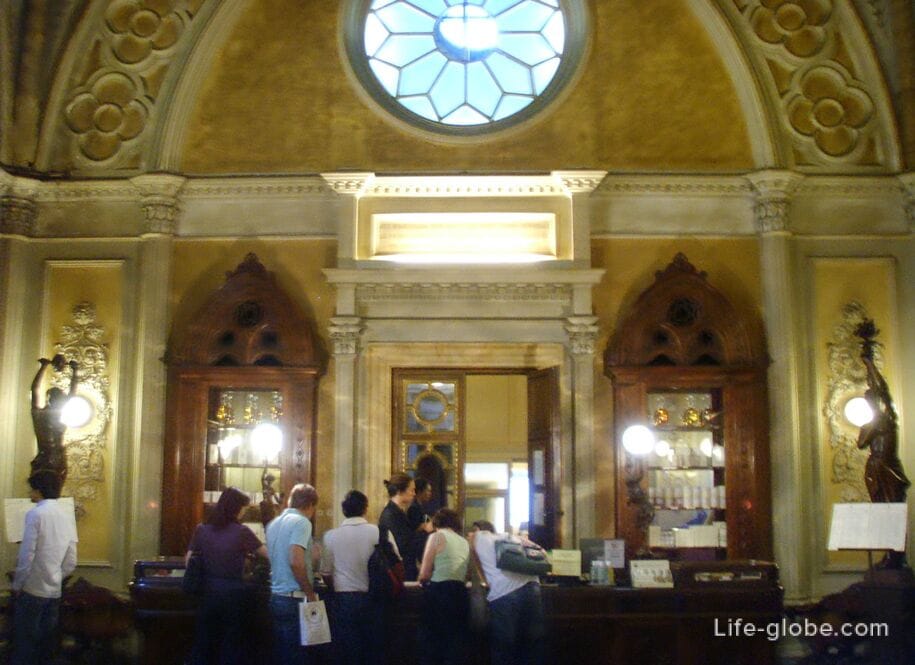
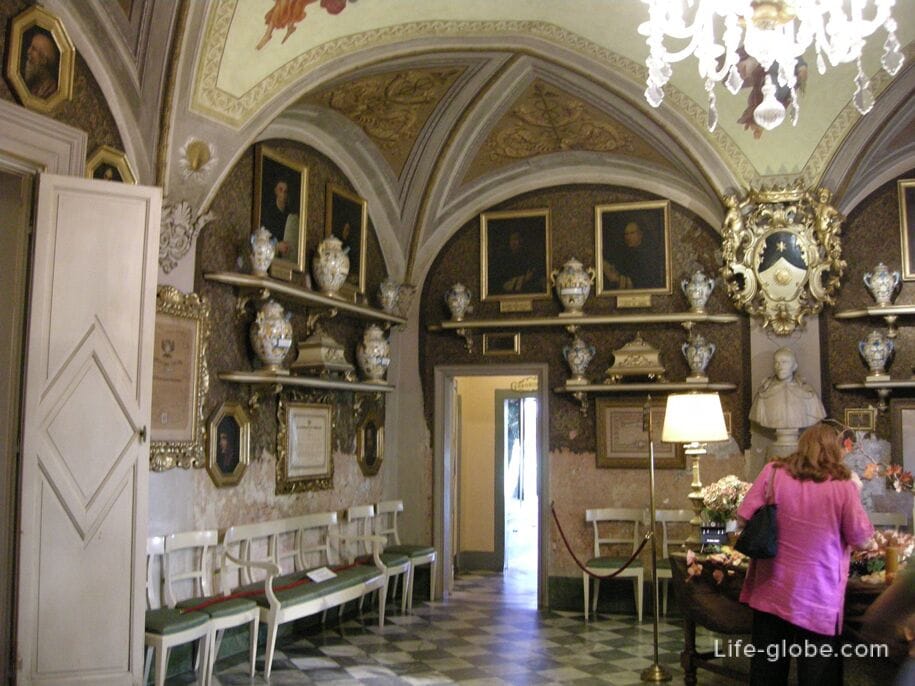
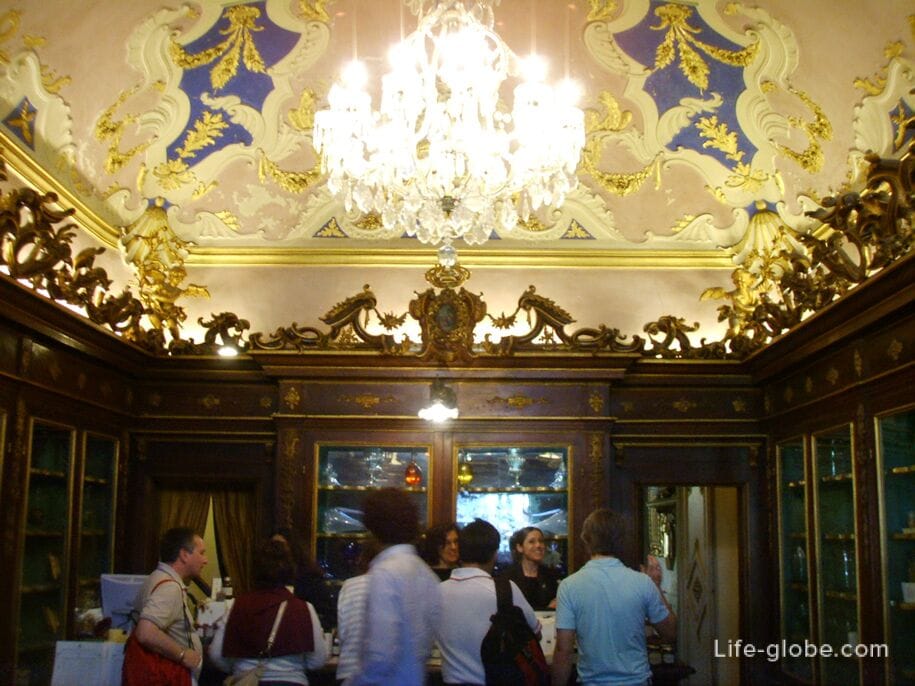
The perfume shop can be accessed through an arched portal made of stone with fine carvings, topped with a pediment, in the center of which is the coat of arms of the Dominican monks, recognizable by the shining sun.
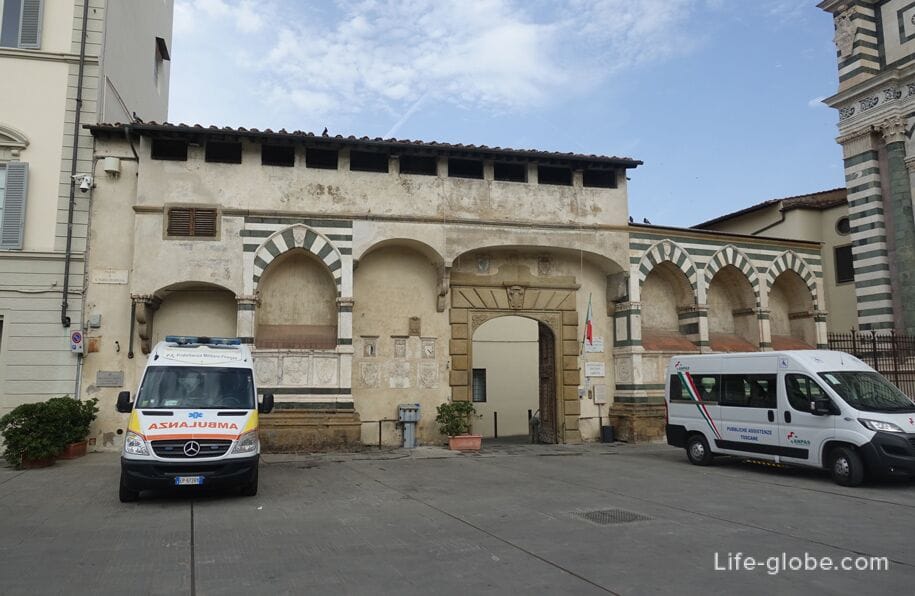
As early as 1381, it is documented that the Dominicans of Santa Maria Novella sold rose water as a disinfectant, especially used during epidemics. The monks grew medicinal plants in the neighboring garden, distilled herbs and flowers, prepared essences, elixirs, ointments and balms. The simple garden mainly supplied the nearby San Marco Pharmacy, which was also founded and operated by Dominican monks.
The current perfumery (an enterprise located outside the pharmacy) dates back to 1612. Renowned throughout Europe, it received the title of His Royal Highness's Foundry from Grand Duke Ferdinando II de' Medici in 1659 under the direction of Fra Angiolo Marchissi. In the 18th century, its products were exported to India and China.
Today it is considered one of the oldest commercial enterprises in all of Europe, operating for more than four centuries. Despite the suppression of the monastery in the nineteenth century, the company remained active thanks to Fra Damiano Beni, and in 1866 became municipal property and was leased by his nephew Cesare Augusto Stefani, whose heirs still run the business.
Practical information
The Basilica of Santa Maria Novella regularly hosts services and religious holidays.
Parts of the complex are open to the public: the whole church, including chapels with frescoes, the sacristy and the Avelli Cemetery; the Santa Maria Novella Museum, which includes the Monastery of the Dead, the Green Monastery, the Spanish Chapel, the Ubriaki Chapel and the refectory.
Temporary exhibitions are held in the museum of the complex.
Entrance to the complex is paid. There are discounted tickets. Free of charge - children under 11 years old, disabled.
Tickets can be purchased at the ticket office of the complex or online in advance on the website.
Information about the complex, open places for visits, opening hours and ticket prices, as well as the time of mass and other information, we recommend checking on the official website of the Santa Maria Novella complex: smn.it.
Santa Maria Novella is located in the historical part of Florence, at the address: Piazza Santa Maria Novella, 18, 50123 Florence, Italy.
Coordinates of Santa Maria Novella: 43°46'27.0"N 11°14'57.0"E (43.774167, 11.249167).
All accommodation facilities in Florence (hotels, apartments, guest houses, etc.), including in the historical center of the city and more remotely from it, can be viewed and booked here




